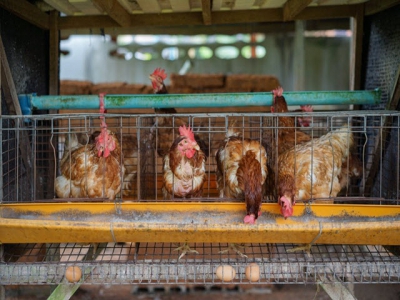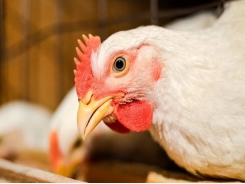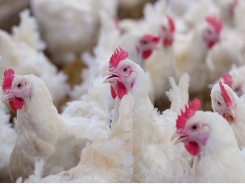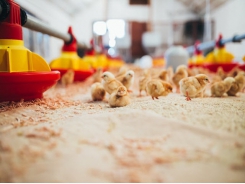Dietary fiber may improve layer microflora, cut noxious gas emissions

Adding sunflower meal to layer diets may lower manure-based emissions of hydrogen sulfide, and improve intestinal microflora, say researchers.
A team of researchers at the University of California explored the use of probiotics and sunflower meal (SFM) in layer diets as a way to alter blood and manure elements. The group published details of its work in the journal, Research in Veterinary Science.
“Probiotics (Lactobacillus strains) alone and in combination with SFM were fed to laying hens to determine effects on (1) early reduction of H2S concentration from laying hen manure and (2) specified serum measurements,” the researchers said.
They found that adding the sunflower meal lowered the total amount of sulfur generated along with hydrogen sulfide (H2S) while increasing sulfate sulfur (SO4-S). It also lowered calcium and phosphorous levels and serum amylase activity.
Use of the probiotic increased the production of SO4-S – the type of sulfur absorbed by plants, they said.
“With caution on mineral absorption, our study supports the commercial application of 20% SFM for laying hens as a reductant for H2S in manure, and likely other volatile suffer compounds, in layer houses,” the researchers said. “Significant effects of SFM are likely due to its beneficial effect on the anaerobic intestinal microflora that ferment fiber.”
Poultry sulfur production, gas emissions
The production and release of hydrogen sulfide (H2S) and other sulfur (S) compounds along with ammonia are some of the gases emitted by animal feeding facilities, the researchers said.
Hydrogen sulfide, however, can have a negative effect on the environment along with human and animal health
Poultry facilities can generate levels of H2S that are higher than human irritation levels, they said. The influence of acute amounts of H2S on laying hens has been linked to increased respiratory frequency and at 0.4% or 4,000 parts per million, death.
Ventilation systems remove H2S and improve facility safety, but the gases may be environmental toxicants, they said.
“Currently, there are no estimates for the contribution of harm to the environment from H2S exhausted from poultry houses; but, negative environmental effects for this compound have been determined,” they added.
“With favorable conditions involving the hydroxyl radical and oxygen gas, it can react to become sulfur dioxide (SO2) and, subsequently, sulfates in the air,” the researchers said. “As well, H2S can be oxidized to SO2 via two intermediates: HS and SO.”
However, more work is needed to find ways to lower the concentration of sulfur-containing compounds in poultry houses, the said.
“Pre-digestion possibilities for inclusion in diets are (1) chicken fat, (2) distillers dried grain plus solubles (DDGS), (3) chlorine dioxide, (4) phytobiotics, (5) prebiotics, and (6) probiotics,” they said. “Of particular interests are use of combinations of probiotics and readily available high-fiber horticultural byproducts.”
Why sunflower meal and lactobacillus?
Some information suggests that adding a blend of probiotics including Lactobacillus paracasei, plantarum, and rhamnosus to broiler diets improved bird egg and meat quality while lowering mortality and the generation of noxious gases, the researchers said.
Lactobacillus strains are recognized for their benefit to digestion, they said. Previous research evaluating the use of the probiotic with broilers reported higher body weights, improved feed conversion ratio and lower cecum pH along with a reduction in odor.
Soybean meal is a common ingredient in poultry feed, however, sunflower meal (SFM) could be an alternative ingredient as it has a high crude protein level and has not been found to reduce the performance of layers or alter egg quality, they said.
It does have a higher fiber content and lower energy values, but it also may increase total non-soluble polysaccharides.
The high fiber level may have a positive influence on production of H2S, they said. Previous research that used high-fiber DDGS in laying hen diets showed a drop in ammonia and H2S from manure.
“Adding probiotics to laying hen diets can improve digestion and nutrient absorption, (thus, improving overall health of chickens) and production measurements,” the researchers said. “At the same time, inclusion of SFM has been shown to not only replace soybean meal at 20% inclusion with no significant changes in the health of poultry; but, also, its high fiber content could act as a feed source for intestinal microflora to promote a healthy gut lining.”
Feeding trial overview
In the feeding trial, 64 layers received one of four diets for a period of 28 days, the researchers said. The first seven days were used as acclimation with sample collection starting on day 8.
The diets included a corn and soy-based control feed, that diet with and added probiotic, the control with added SFM at 20% or the control diet with both a probiotic and 20% SFM, they said.
Bird manure samples were gathered ever four days following the acclimation period, they said. It was analyzed for H2S concentration, total sulfur and sulfate-sulfur (SO4-S).
Blood samples were gathered from all birds at the end of the study and checked for amylase, total cholesterol, triglycerides, calcium and phosphorus, the researchers said.
Results
Overall, the probiotic blend was not found to significantly alter H2S production in bird manure, but probiotic use did increase the production of SO4-S, the researchers said. The increase of total sulfur by day expanded more in diets with the probiotic than in the control.
Use of the probiotic also was not found to significantly alter the serum measurements, they added.
Adding SFM lowered H2S concentrations in the manure by 59.4% compared to the control, they said. The meal additive also generated lower levels of total sulfur compared to the control.
“The effect of SFM on H2S, TS, and SO4-S were significant,” the researchers said. “Crude fiber in both diets containing 20% SFM was 6.58% compared to 2.32% for the diets without SFM. Thus, a difference of 4.26% crude fiber resulted in a lower H2S concentration in manure.”
The feed additive also lowered amylase, calcium and phosphorus in serum, but did not alter cholesterol or triglycerides, they said.
Source: Research in Veterinary Science
Authors: K. Saksrithai, A. King
Related news
Tools

Phối trộn thức ăn chăn nuôi

Pha dung dịch thủy canh

Định mức cho tôm ăn

Phối trộn phân bón NPK

Xác định tỷ lệ tôm sống

Chuyển đổi đơn vị phân bón

Xác định công suất sục khí

Chuyển đổi đơn vị tôm

Tính diện tích nhà kính

Tính thể tích ao




 Eavesdropping may provide animal health, welfare insights
Eavesdropping may provide animal health, welfare insights  Enzyme cocktail may boost bird growth, energy use
Enzyme cocktail may boost bird growth, energy use